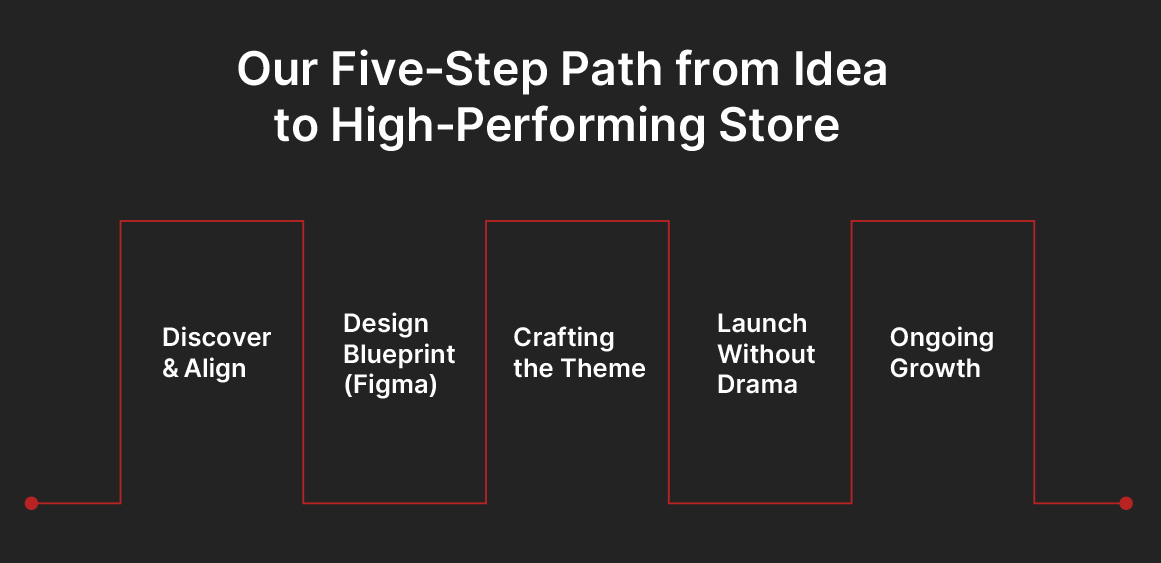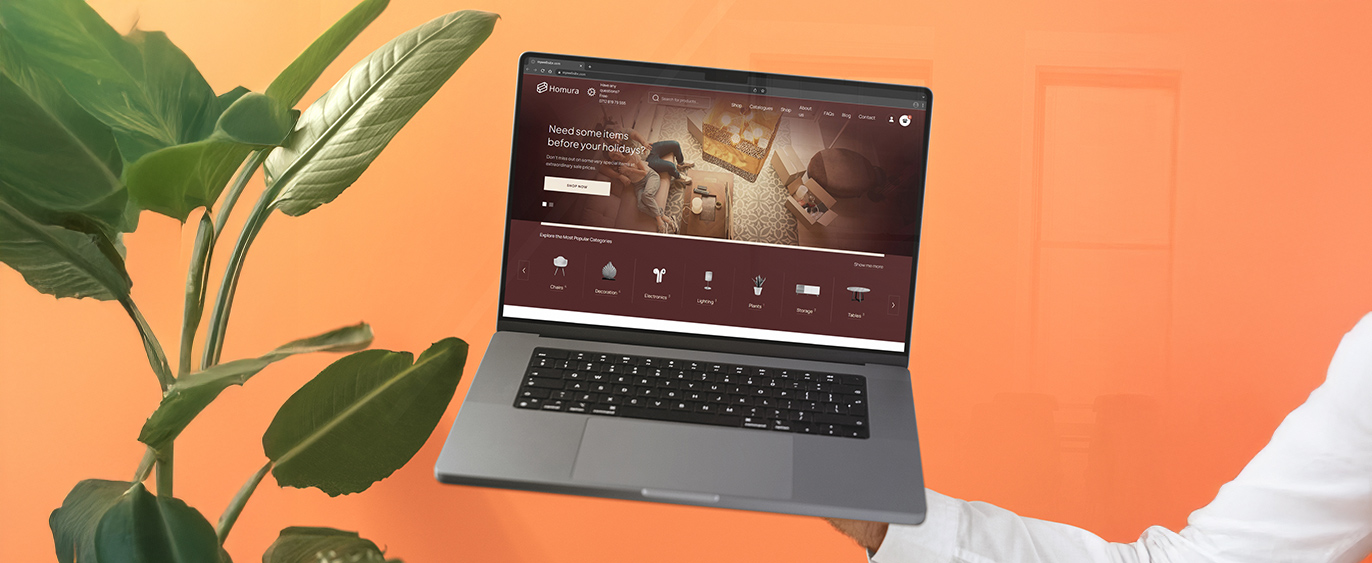
Introduction
Launching on Shopify with an off‑the‑shelf theme is a smart way to test the market quickly, but the convenience that fuels early momentum can later throttle growth. As product lines multiply, influencer collaborations drive surges in mobile traffic, and marketing teams demand ever‑bolder storytelling, a “good‑enough” template starts to crack. Page loads slow under bloated code, simple layout changes require developer intervention, and your brand—once distinctive—begins to disappear in a sea of stores running the same design.
The solution is a custom Shopify theme that shifts your storefront from generic to genuinely strategic. Purpose‑built architecture sheds unnecessary weight integrates mission‑critical features natively and gives non‑technical teams drag‑and‑drop control over merchandising—turning every campaign into a speed‑to‑market advantage. In the sections that follow, we break down Fineart Design Agency’s end‑to‑end methodology—discovery, design, development, launch, and continuous optimization—and illustrate how it transforms growth ambitions into a high‑performing store that loads in a heartbeat, amplifies brand equity, and converts visitors into loyal customers.
Templates vs Custom: Where Growth Gets Stuck
Marketplace themes are unbeatable for speed-to-launch, yet their one‑size‑fits‑all DNA soon reveals hard limits. As your catalogue grows and campaigns ramp up, four red flags typically surface:
- Slow‑Loading Mobile Pages
You invest in paid traffic, but the hero image hasn’t appeared before impatient shoppers hit the back button. Bloated, one‑size code is stealing conversion. - Rigid Layouts
Marketing needs a new bundle module or promotional banner. The template can’t accommodate it, so every “quick tweak” turns into a mini dev project. - Brand Dilution
What was once a distinctive skincare experience now looks indistinguishable from a novelty tee shop—because thousands of stores share the same visual skeleton. - App Overload
Missing features push you to install “just one more” plugin. Each adds scripts, slows performance, and inflates monthly SaaS fees.
A custom theme tackles these pain points at the root. Fineart trims excess code, embeds critical features natively, and equips your team with drag‑and‑drop sections that can be rearranged without technical help. The result—lighter pages, stronger brand presence, and lower recurring costs—often pays for itself in a single sales season through higher conversion and reduced app spend.
Our Five‑Step Path from Idea to High‑Performing Store

Fineart follows the same clear, five‑step framework on every custom build. Each stage removes guesswork, keeps budgets predictable, and ties design decisions back to your business goals.
- Discover & Align
- Talk to founders, marketers, ops, and support in quick 30‑minute calls.
- Dig into GA4 funnels, Hotjar heat‑maps, support tickets, and product reviews to spot real friction.
- Screen‑record 5–7 competitor stores to see what shoppers already expect—and where you can leap ahead.
- Map the tech stack (apps, payments, fulfilment, loyalty) so design never fights your operations.
- Outcome: a two‑page Design Brief linking every KPI (higher AOV, lower returns, global reach) to a concrete feature or layout requirement.
- Design Blueprint (Figma)
- Build a one‑page moodboard to lock colour, type, and imagery in an afternoon. Create a token‑driven component library—buttons,
- badges, product cards—that stays on brand everywhere.
- Wire‑frame mobile‑first layouts; desktops inherit the mobile logic, guaranteeing thumb‑friendly UX.
- Share an interactive Figma prototype you can click through on your phone; leave sticky‑note comments we resolve within 24 hours.
- Why it rocks: future promos become drag‑and‑drop edits, not fresh dev tickets. See live examples in our eCommerce Design Gallery.
- Crafting the Theme
- Translate design tokens into lean Liquid and SCSS.
- Package every feature as an Online Store 2.0 section you can reorder in Shopify’s Theme Editor.
- Re‑create heavy app functions (stock countdowns, trust bars) directly in code to cut page weight and subscription fees.
- Optimise images (WebP/AVIF), lazy‑load video, and load JavaScript only where it’s needed.
- Record Loom walkthroughs and hand over a Git repo so your team truly owns the store.
- Quick fact: shaving 0.1 s off mobile load time can lift conversion up to 8 % (Google/SOASTA).
- Launch Without Drama
- Manually walk through carts and checkouts on real iPhones, Androids, and desktops.
- Run automated Axe scans plus keyboard checks to lock in WCAG 2.2 AA accessibility.
- Verify meta tags, JSON‑LD schema, GA4, and pixel events—before Google crawls the new site.
- Go live during a low‑traffic window with an instant rollback plan and real‑time speed alerts.
- Train staff via a recorded screen‑share: adding products, duplicating sections, swapping banners takes minutes.
- Ongoing Growth
- Run one data‑backed A/B test every month—adopt only proven winners.
- Refresh colours, copy, or hero layouts seasonally via design tokens—no code required.
- Re‑audit speed, accessibility, and SEO every quarter so the store stays ahead of Google updates and shopper expectations.
- Learn how our Continuous Optimisation Retainer compounds revenue over time.
Discover & Align: Turning Ambition into a Design Brief
Effective design begins with precise objectives. In a concise kickoff session, we bring every key voice to the table—founder, marketing lead, operations, and support—to define success in plain language: “lift average order value,” “reduce ‘Where’s my order?’ tickets by half,” or “expand into new regions without extra headcount.” Those aspirations are then grounded in real evidence:
Analytics & heat‑maps – Pinpoint where visitors hesitate, rage‑click, or abandon checkout.
Support logs – Reveal recurring pain points such as “size guide hard to find” or “payment keeps failing.”
Competitor tear‑downs – Identify UX conventions shoppers already trust and highlight gaps your brand can own.
Tech & operations audit – Map fulfilment workflows, loyalty programs, and payment gateways so new features enhance—never disrupt—daily operations.
The findings converge in a concise, two‑page Design Requirements Brief that connects every pixel we design to your quantifiable business targets. No fluff, no scope creep—just a clear roadmap everyone can rally behind.
Design Blueprint: Building Blocks that Stay On‑Brand
With the brief approved, we open Figma—not code editors—to craft a visual language that can grow with your catalogue.
Moodboard & Tone
We blend product photography, colour swatches, and type pairings into a single canvas. Stakeholders vote with emojis, so consensus forms in minutes, not weeks.
Reusable Component Library
Think of buttons, badges, and product cards as LEGO® bricks. Each follows the rules set in your moodboard: colour contrast, font size, border radius. When marketing needs a holiday hero or a “New In” slider, they simply snap existing bricks together—brand consistency guaranteed.
Mobile‑First Layouts
Over 70 % of Shopify traffic is mobile. We design for thumbs first: large tap targets, thumb‑reachable CTAs, and lazy‑loaded media so scroll feels snappy even on mid‑range phones.
Clickable Prototype
Before a single line of Liquid is written, you receive a link that opens like a real store on your phone. Want the cart icon bigger? Prefer the hero headline shorter? Leave a sticky‑note comment; we adjust in hours, not days.
Brand Story & Content Flow: Guiding Shoppers from Curiosity to Checkout

Even the sharpest visual design falls flat without a coherent narrative. Our approach layers copy, imagery, and gentle prompts so every visitor glides from discover → consider → commit.
- The Three‑Second Headline
The hero banner must answer “Is this for me?” at a glance—e.g., “Plant‑Powered Skincare for Sensitive Skin.” Clarity first, cleverness second. - Story‑Driven Collections
We replace bland “All Products” grids with need‑based groupings—think “Desk‑Friendly Tech” or “Monsoon‑Ready Gear.” Shoppers instantly picture use cases and are more likely to bundle complementary items. - Confidence‑Building Product Pages
- Social proof in prime view—star ratings and review snippets sit beside the price, not buried below the fold.
- Micromotions on scroll—ingredient spotlights or feature callouts animate subtly to maintain engagement without distraction.
- Assurance cues—return policy, secure‑payment icons, and delivery time frames align directly under the “Add to Cart” button to calm last‑minute doubts.
- Smart, Subtle Nudges
- A mini‑cart progress bar shows how close the order is to free shipping.
- Real‑time stock indicators and back‑in‑stock alerts are baked into the theme code, adopting your colour palette instantly and adding zero third‑party lag.
By orchestrating these elements, we transform static pages into a guided shopping journey that feels intuitive, trustworthy, and unmistakably on brand.
Launch & Continuous Growth — Day One Is Just the Beginning
Soft Launch + Live Monitoring
-We release the new theme during your quietest traffic window and track performance in real time.
-If mobile Largest Contentful Paint creeps past 2.5 seconds, we compress media or defer assets immediately.
-Any anomaly—broken link, spike in error logs—triggers an automatic rollback plan so customers never feel the hiccup.
Rapid Polish: The First 30 Days
-Heat‑maps and session replays spotlight micro‑friction: a low‑contrast “Add” button on certain Android devices or an FAQ link crowding the scroll bar.
-Fast, iterative tweaks here protect the ad spend you’ll pour in once traffic scales.
Quarterly CRO Sprints
-Every 90 days we choose one high‑impact hypothesis—for example, “Does a sticky ‘Buy Now’ bar on mobile increase conversion?”
-We design the variant, run a clean 50/50 A/B test, and keep changes only if the data proves a measurable lift.
-The process repeats, steadily compounding revenue without drastic overhauls.
Evergreen Refreshes
-Because the hero, announcement bar, and trust strip are modular components, marketing can swap colours, copy, or layout in a single work session—perfect for flash sales or seasonal campaigns.
Why Partner with Fineart Design Agency
- Direct Access to Specialists
You’ll collaborate daily with the very designer and Shopify engineer building your theme—no account‑manager middle layer, no diluted feedback loops. Questions get answered in minutes, and creative decisions stay aligned with your vision. - Fixed‑Scope, Zero‑Surprise Pricing
Every proposal itemises deliverables, timelines, and costs up front. Milestone‑based invoices keep cash‑flow predictable and guarantee that added ideas are discussed and priced before work begins. - Hands‑On Training & Living Documentation
Post‑launch, we hand over concise Loom tutorials and a private Notion playbook that show your team how to add products, schedule sales, or tweak banners—empowering marketers to move fast without calling a developer. - Demonstrated Performance Gains
Our custom builds routinely cut mobile load times by 40 percent or more and lift conversion rates between 20 and 45 percent. Detailed case studies are available on request to validate the numbers against real‑world results.
Conclusion
Templates can take you from zero to launch day, but they rarely carry you the next mile—especially when each added app chips away at speed and brand clarity. A custom Shopify theme is the difference between renting a storefront on a crowded street and owning a purpose‑built flagship that reflects your brand’s voice on every shelf. Fineart Design Agency blends strategy, design, and lean engineering to craft stores that feel bespoke, load lightning‑fast, and empower in‑house teams to grow without technical bottlenecks.
Ready to trade template limitations for a storefront that scales with every new product drop and campaign? Contact Fineart Design Agency today—let’s build an eCommerce experience as unique as your brand.



